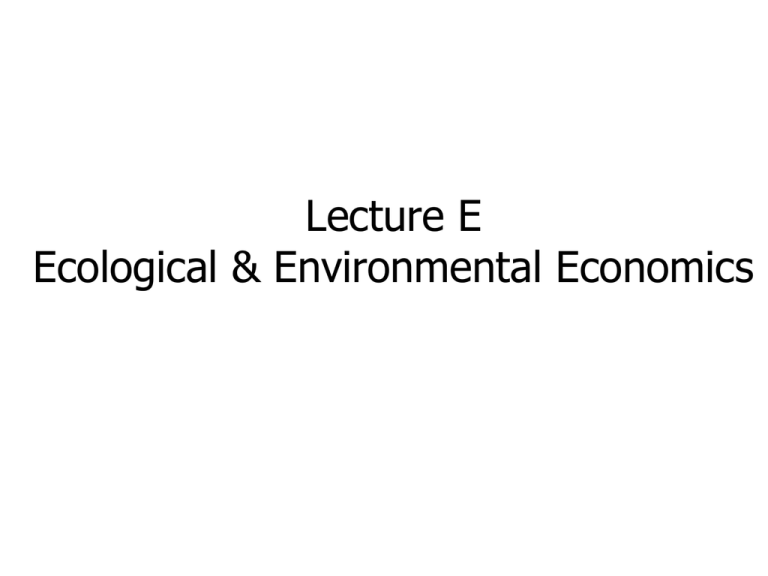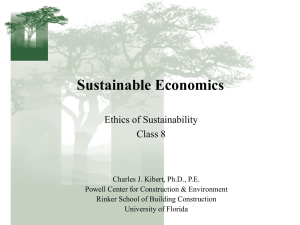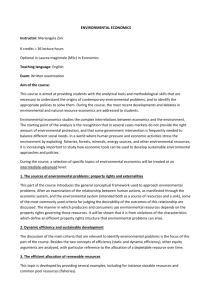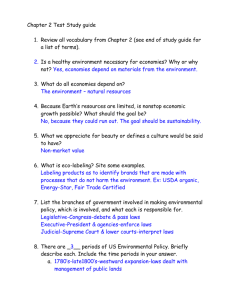Lecture E Ecological Economics
advertisement

Lecture E Ecological & Environmental Economics Overview • Terminology • Conflicting views of the economy’s relationship to nature • No-Limits versus Limits to the economy views • Problems with current economic theory & reality • Changing signals to the economy and internalization • Economy behaving like an ecosystem • Alternatives to measuring welfare by GDP • Globalization • Dow Jones Sustainability Index • Summary and Conclusions Economics Terminology • Economics: the study of the allocation of scarce means among competing ends. (Daly) • Capital: wealth of property that is used or invested to produce more wealth; the money with which an enterprise is started. Set of all physical things capable of satisfying human wants and subject to ownership. Fisher (1906) – natural, human, manmade, critical natural • Wealth: Riches, possession of these. • Riches: a great quantity of money or property or valuable possessions. • Money: portable pieces that can be used as a medium of exchange. Banknotes or coins. More... • Technology: mechanical arts and applied sciences. • Growth: increasing in size by accretion or assimilation of material. A quantitative increase in physical dimensions or size. • Economic Growth: rising aggregate consumption (C) or output (Q). • Development: bring to a fuller, greater, or better state. Empty World View – Herman Daly Full World View Physical Limits to Economy • Malthus: absolute limits or scarcity • Ricardo: relative limits • Marx: limits due to social and political unrest Malthus Diagram Closed Economic System Capital Stock Technology Stock Production Labor Output Consumption Households Capital Investment Technology Investment Source: Pezzey Economy with Environmental Considerations Environmental Productivity Capital Stock Environmental Quality Natural Resource Stocks Renewable NonPollution Resources Renewable Stock Resources Technology Stock Production Labor Output Waste Flows Households Capital Investment Consumption Utility Environmental Amenity Technology Investment Clean Up Expenditure Source: Pezzey Prevailing Economic System • • • • • Private ownership of material resources Public ownership of “sinks” Perfect functioning of the market Infinite subsitutability of resources Subsidized disposal, energy, water Mainstream economics FALLACIES • Marie Antoinette Economics let agriculture fall, consume other 97% of GNP • Technological cavalry will save us we can substitute for soil, air, water, forests... • “Not Beating the Wife As Much As Before” false complacency for partial success Source: Davidson, E.A., You can’t eat GNP, Perseus, Cambridge MA 2000. Main problems with current economic theory Externalities - costs not borne by those who create them Badly defined property rights - environmental goods perceived as commons The environment is not subject of rights - the environment’s interests are not legally represented in the economic system Externalities - Are equal to expenses on the elimination of a problem. - Distort the economic rationality by influencing decisions on the allocation of means. - Are reflected in the revenues of the whole social or consumer groups (e.g. by making other economic actors pay for the pollution caused by them, some companies are ‘subsidized by those who incur those costs) - May lead to exploitation of some geographical regions by others when regional distribution of labor is taken into account (e.g. migration of polluting industries) Problems with Current Economic Theory • Assumes market prices reflect consumer willingness to pay. • Assumes that consumers are the best judge of value and that community considerations are irrelevant. • Assumes consumers understand the value of ecological resources provided by many biological resources. Assumes consumer, aided by the market place, knows which species are unnecessary for ecosystem maintenance. • Assessment of economic value ignores many equity and moral considerations. • General failure to recognize that market prices are highly distorted. M.D. Young, Sustainable Investment and Resource Use, Parthenon Publishing Group, 1992, 24-25. Socialism collapsed because it did not allow prices to tell the economic truth. Capitalism may collapse because it does not allow prices to tell the ecological truth. Source: Dahle, 2001. Worth of Ecosystem • Costanza et al 1997, “The value of the world’s ecosytem goods and services,” Nature, 387:253-260. – Pollination, Raw Materials Production, Water Supply, Waste Recycling & Pollution Control, Recreation & Education, Climate and Atmosphere Regulation, Soil Formation and Erosion Control, Control of Pests & Diseases • Value of services: US$16 to $US54 trillion • World GNP: US$18 trillion • Ecosystem-to-GNP ratio 1.8 Changing the Signals to the Economy • Currently taxes are applied to positive aspects of behavior: wages, productivity, profit • It would be better to tax aspects that are negative: waste, inefficiency, pollution • Possible mechanisms: – Pollution taxes – Tradable pollution permits – Deposit fees • Shifting impacts of production to producers is called “internalization” Internalization • Benefits of Internalization Processes • Transparency • Across All Sectors • Flexibility • Stimulates Innovation • Polluter Pays • Caveat: must be transnational • Cooperation between sectors • Another example of interconnectedness Government Use of Internalization Processes Regulations Performance Standards Manufacturer Responsibility Subsidies Permits Taxes : “Tax pollution, not production” -Pollution, excise, severance, tax credits Alternative National Accounting Systems Government as Purchaser and Facilitator (Recycled Content Products/EPA Green Lights Tax Base Productive A ctivities Examples Effects Taxes on sales, Distortionary: Discourages income, what it taxes, reducing pay roll, employ ment and earnings corporate profits Excess Profits Taxes on Neutral: Shares with society the from Natural logging in excess profits that are generated Resource Use virgin forests, by rising prices from natural fishing resources, which are caused by global demand and dwindling supplies. Neither encourages or discourages what it taxes, since resource users still earn a fair profit. Environmental Taxes on Corrective: Makes polluters Destruction water and air experience the full costs of what pollutants they do, encouraging them to such as reduce the economic toll on this fertilizer runand future generations. off and lead Table 2 Global taxing priorities (Roodman 1 995) How Common Very common - the source of most revenue in industrial countries Rare Becoming more common, but except for energy taxes not major revenue sources. Tax shifts from work & investment to environmental damage Country, year initiated Taxes Cut On Taxes Raised On Revenue Shifted (%) Sweden, 1991 Personal Income Carbon and Sulfur Emissions Denmark, 1994 Personal Income Motor fuel, coal, electricity, 2.5 water sales Spain, 1995 Wages Motor fuel sales 0.2 Denmark, 1996 Wages, agricultrual property Carbon emissions; pesticide, chlorinated solvents, battery sales 0.5 Netherlands, 1996 Personal income Natural gas and electricity & wages sales 0.8 United Kingdom, 1996-7 Wages 0.2 Finland, 1996-7 Personal income Energy sales; landfilling & wages Landfilling 1.9 0.5 Current Global Tax Revenues 4% 3% Work and Investment Resource Windfalls Environmental Damage 93% Full Reform of Global Tax Revenues 15% Work and Investment Subsidy Cuts Resource Windfalls Environmental Damage 12% 8% 65% Sustainable Economic System • Understands primary role of natural systems in the economy • Integrates functions of industrial and natural “ecologies” • Accounts for true costs of waste and disposal • Cradle-to-Grave responsibility for products • Penalizes waste, rewards efficiency • Provides for fair, just, meaningful, and fulfilling employment of human resources Ecological Economics • A new transdisciplinary field addressing the relationship between ecosystems and economic systems in the broadest sense. • Uses the tools of conventional economics and ecology as appropriate. • Need to establish institutions that take the long term view, a la biology. • Economics as an ecological system. R. Costanza, Ed. Ecological Economics, The Science and Management of Sustainability, Columbia University Press, 1991, 3-7. Relationships of Economic Schools Some Ecological & Environmental EconomicsTerms • Hicksian Income: income that does not forego future opportunities for others; living off nature’s interest not its capital • Pigou’s Externalities a Pigouvian Tax is on paid by polluters equal to the marginal external cost borne by the pollutees. The polluter is thus informed about the full social costs of his operations and the victims can be fairly reimbursed (1920). • Solow Criterion: Solow stated that substitutability would allow man to get along without natural resources (1974). • The Hartwick-Solow Rule: Manufactured capital can substitute for natural capital Hicksian Income ...income that can be consumed without reducing future consumption possiblities Hartwick-Solow Rule Value of savings >= Value of Manufactured Capital Deterioration + Value of natural Capital Depletion/ Degradation The amount a society must save and reinvest to maintain capital intact. The total capital stock (natural plus manufactured must be nondeclining. D. Pearce et al. The Economics of Sustainable Development, Ann. Rev. of Energy Environ. 1994. 19: 457-474. The Ecological Economists • Kenneth Boulding (1910-1992): The Economics of the Coming Spaceship Earth (1966) • Nicholas Georgescu-Roegen (1906-1994): The Entropy Law and Economic Progress- the economy is not a reversible mechanical systems but subject to the 2nd Law • Herman Daly: student of N. G-R., steady state economy Gowdy, J. and Sabine O’Hara, Economic Theory for Environmentalists, St Lucie Press, 1995, 129-132. Biological Basis for the Economy • A.J. Lotka: “The Earth Machine” or the “Mill Wheel of Life” • J.A. Hobson : organic test as the test of welfare • N. Georgescu-Roegen: thermodynamic limits, biophysical foundations of the economy • M.K. Hubbert: biophysical constraints to economic growth • H.T. Odum: economy as an ecosystem • G. Hardin: institutional conditions for overexploitation • M. Rothschild: Bionomics - genetic material of the economy is technology Economy like ecosystem? • Eugene Odum: – young ecosystems: production, growth, quantity – mature ecosystems: protection, stability, quality • Today’s economy is like a young ecosystem • How do we create an economy that is like a mature ecosystem? The metabolic analogy Metabolism Anabolism Catabolism Useful matter Distribution Useful Energy Degraded matter Degraded energy Economics Anabolism Catabolism Useful matter Distribution Useful Energy Time Totally degraded matter Totally degraded energy Bionomics • The economy behaves like a biological system • Behavior of biological systems applied to economics • Excellent forecasting tool (e.g. AT&T demand for telephone service) Alternative Measures of Welfare (Examples) • Index of Sustainable Economic Welfare (ISEW) • Genuine Progress Indicator (GPI) • Human Development Index (HDI) Human Development Index • Created by the United Nations Development Program (UNDP) • A composite of three indicators – Longevity: life expectancy – Knowledge: literacy, years of schooling – Standard of Living: purchasing power based on GDP/capita Genuine Progress Indicator • Developed by non-profit: Redefining Progress • Starts with real personal consumption, adjusts for income distribution • Subtracts: – – – – – – – Crime & Divorce Resource depletion Environmental Damage Income Distribution Pollution Lifespan of durable goods & public infrastructure Dependence on foreign assets • Adds: – Value of household work and parenting – Value of volunteer work INDEX OF SUSTAINABLE ECONOMIC WELFARE – U.S., 1990 (Constant billion $ of 1972 Personal income adjusted for income distribution $1,164 +services for household labor +520 +services of consumer durable goods +225 +services of highways and streets +18 +consumption public spending on health/education +45 -consumer spending on durable goods -225 -defensive private spending on health and education -63 -cost of commuting and auto accidents -67 -cost of personal pollution control -5 -cost of air, water, and noise pollution -39 -lost of wetlands and farmland -58 -depletion of natural resources -313 -long term damage from nuclear wastes, ozone depletion, and greenhouse gases -371 +net capital growth +29 +/- net international investment position -34 INDEX OF SUSTAINABLE ECONOMIC WELFARE $818 Globalization • The World Trade Organization (WTO) (1995) • Established by final act of Uruguay Round of Multilateral Trade Negotiations in Marrakech in April 1994 – Goal is to remove all obstacles to trade • How a product is made • By whom • What happens when it is made – Result: Countries and regions cannot set standards, express values, or determine what they do or do not support – Outcomes: Child labor, prison labor, forced labor, substandard working conditions and wages, environmental destruction, habitat loss, toxic waste production, synthetic hormones, genetically engineered materials • Membership: 135 countries (but no plebiscite was held!) • Violates Agenda 21 and the Universal Declaration of Human Rights Case Study: Chiquita Brands International • Chiquita Brands International is a $2 billion company • Main product is bananas from Central America • History of labor abuses, heavy pesticide use (dichloropropane), resulting in birth defects and infertility • European countries biased import policy for bananas to small family farmers using fewer chemicals • U.S. sued and in WTO arbitrated case and won, forcing European countries to eliminate their bias • Other cases: Countries must allow McDonald’s, Blockbuster, Pizza Hut, etc. to operate within their borders Dow Jones Sustainability Index Dow Jones Trend Dow Jones Sustainability Index vs S&P 500 Leading DJ Sustainability Firms • Consumer – – – – BMW AG, Germany Fuji Photo, Japan Unilever Plc., Netherlands Bristol-Myers Squibb, US • Energy – Suncor Energy, Canada – Enbridge Inc., Canada • Utilities – Deutsche Telekom AG, Germany – TransAlta Corp., Canada • Financial – Credit Suisse Group, CH – Skandia Forsakrings AB, SW • Industrial – Honeywell Inc., US – Tomra Systems ASA, Norway • Technology – Fugitsu Ltd., Japan – ST Microelectronics, France BP: Sustainable profits? World’s largest supplier of solar modules $200 million/yr $1 billion/yr by 2007 Solar-powered H2O electrolysis: hydrogen buses WBCSD, US Members • • • • • • • • • • • • • • • • 3M Company Alcoa AT&T Arthur D. Little The Boston Consulting Group Cargill Incorporated CEMEX CH2M Hill Conoco Dow Chemical Company DuPont Eastman Kodak Company Ford Motor Company General Motors Corporation Interface International Paper Monsanto Company Johnson & Johnson Phelps Dodge Procter & Gamble Company Rohm and Haas S.C. Johnson & Son Suncor Energy Inc Texaco Time Warner Unocal Westvaco Corporation Weyerhaeuser Company Xerox Corporation Main Points • Everything is connected • The result is there are feedback loops between all elements of the system • Maldistribution of wealth is prevalent but not sustainable • GDP and GNP do not really represent ‘welfare’ just economic throughput • The economy responds to signals it is sent – – – – – Cheap waste disposal Low costs for emissions (air, water, land) Low cost for environmental impacts Cheap and subsidized resources Tax benefits for resource depletion • How do you change the signals to the economy? Summary and Conclusions • The current economic system is not sustainable – – – – Depends on the scale of material/energy throughput Subsidizes resource extraction and pollution Taxes productive activities Does not measure ‘welfare’ • A system based on Ecological Economics would: – Shift taxes to waste, inefficiency, and pollution, away from wages, profits, productivity, and investment – Focus on dematerialization, deenergization, decarbonization, and detoxification – Measure welfare instead of absolute monetary transactions – Support an EcoIndustrial revolution







